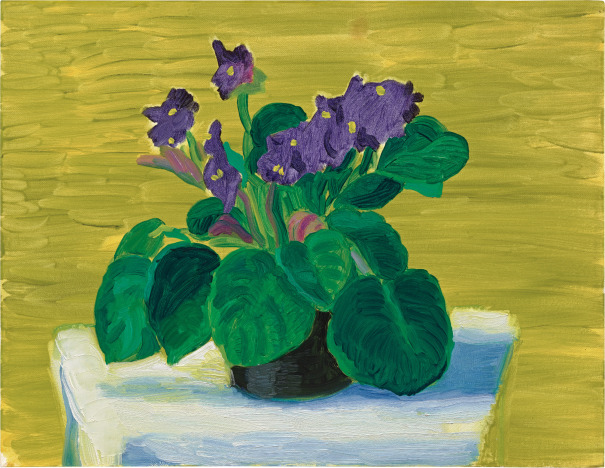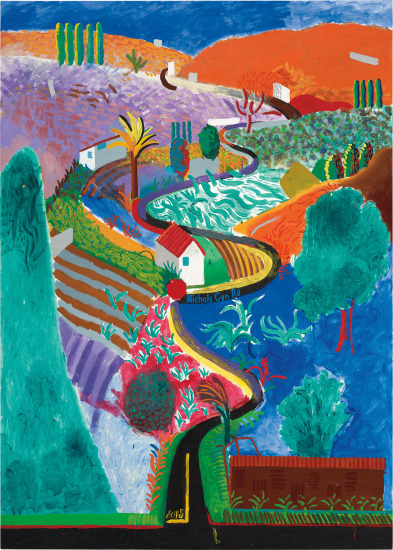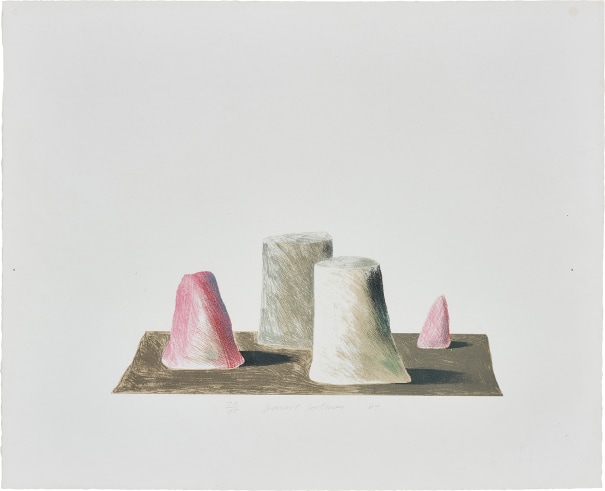David Hockney Walking in the Zen Garden at the Ryoanji Temple, Kyoto, Feb. 21st 1983 Photographic collage, in the artist’s original frame. 40 x 62 1/2 in. (101.6 x 158.8 cm). Signed, titled, numbered 14 in ink on the mount. Number 14 from an edition of 20.
Literature Arts Council of Great Britain, Hockney's Photographs, p. 28; Knopf, Camera Works: David Hockney pl. 104; Nishimura Gallery, David Hockney New Work with a Camera, pl. 11 Catalogue Essay By the late 1960s, David Hockney had firmly established his reputation as a leading figure in the Contemporary Art world. With a California backdrop, his portraits of friends and lovers came to define West-Coast American painting, and while photography had always played an integral role in this work as source material, it was not until the 1970s that Hockney began experimenting with the photograph itself as a work of art. His earliest photo-based works or “joiners,” were grids of photographs that together comprised the singular image that he intended. In 1982 he created his first photocollage. Combining various vantage points, Hockney’s photocollages depict comprehensive scenes that transcend the traditional limits of photography and representational art. Both visually and conceptually, they reference Pablo Picasso and his strong influence on Hockney: the repetition of the 4 x 5 in. photographs provides the geometric aesthetic of Cubism, while Hockney’s layering of image upon image provides the fluidity and three dimensional space that was at the heart of Picasso’s work. But beyond this, as the artist himself noted in an interview with Lawrence Weschler, what interested Hockney most was the way these photocollages present the world in a manner much closer to the complex way in which we see and interpret our surroundings: “I realized that this sort of picture came closer to how we actually see, which is to say, not all-at-once but rather in discreet, separate glimpses which we then build up into our continuous experience of the world.” (Knopf, Camera Works: David Hockney p. 11) In Walking in the Zen Garden at the Ryoanji Temple Kyoto, Feb. 21st, 1983, all of Hockney’s ideas and intentions for his photocollages come to fruition, with each of the approximate 130 photographs serving as a brushstroke on this alternate canvas. Individually, they are abstracted, revealing only a portion of the scene; but together they create a cohesive atmospheric sense of space that conveys not only the image but the experience of Hockney’s journey through the garden. From the details of Hockney’s footsteps that border the bottom edge to the sculptural surface of the isolated rocks in the distance and the delicate play of light and shadow, Hockney’s photocollage demonstrates a continuation of the artistic interest seen throughout his paintings. Read More
David Hockney Walking in the Zen Garden at the Ryoanji Temple, Kyoto, Feb. 21st 1983 Photographic collage, in the artist’s original frame. 40 x 62 1/2 in. (101.6 x 158.8 cm). Signed, titled, numbered 14 in ink on the mount. Number 14 from an edition of 20.
Literature Arts Council of Great Britain, Hockney's Photographs, p. 28; Knopf, Camera Works: David Hockney pl. 104; Nishimura Gallery, David Hockney New Work with a Camera, pl. 11 Catalogue Essay By the late 1960s, David Hockney had firmly established his reputation as a leading figure in the Contemporary Art world. With a California backdrop, his portraits of friends and lovers came to define West-Coast American painting, and while photography had always played an integral role in this work as source material, it was not until the 1970s that Hockney began experimenting with the photograph itself as a work of art. His earliest photo-based works or “joiners,” were grids of photographs that together comprised the singular image that he intended. In 1982 he created his first photocollage. Combining various vantage points, Hockney’s photocollages depict comprehensive scenes that transcend the traditional limits of photography and representational art. Both visually and conceptually, they reference Pablo Picasso and his strong influence on Hockney: the repetition of the 4 x 5 in. photographs provides the geometric aesthetic of Cubism, while Hockney’s layering of image upon image provides the fluidity and three dimensional space that was at the heart of Picasso’s work. But beyond this, as the artist himself noted in an interview with Lawrence Weschler, what interested Hockney most was the way these photocollages present the world in a manner much closer to the complex way in which we see and interpret our surroundings: “I realized that this sort of picture came closer to how we actually see, which is to say, not all-at-once but rather in discreet, separate glimpses which we then build up into our continuous experience of the world.” (Knopf, Camera Works: David Hockney p. 11) In Walking in the Zen Garden at the Ryoanji Temple Kyoto, Feb. 21st, 1983, all of Hockney’s ideas and intentions for his photocollages come to fruition, with each of the approximate 130 photographs serving as a brushstroke on this alternate canvas. Individually, they are abstracted, revealing only a portion of the scene; but together they create a cohesive atmospheric sense of space that conveys not only the image but the experience of Hockney’s journey through the garden. From the details of Hockney’s footsteps that border the bottom edge to the sculptural surface of the isolated rocks in the distance and the delicate play of light and shadow, Hockney’s photocollage demonstrates a continuation of the artistic interest seen throughout his paintings. Read More
.jpg)
.jpg)



.jpg)

.jpg)
.jpg)
.jpg)
.jpg)
Testen Sie LotSearch und seine Premium-Features 7 Tage - ohne Kosten!
Lassen Sie sich automatisch über neue Objekte in kommenden Auktionen benachrichtigen.
Suchauftrag anlegen